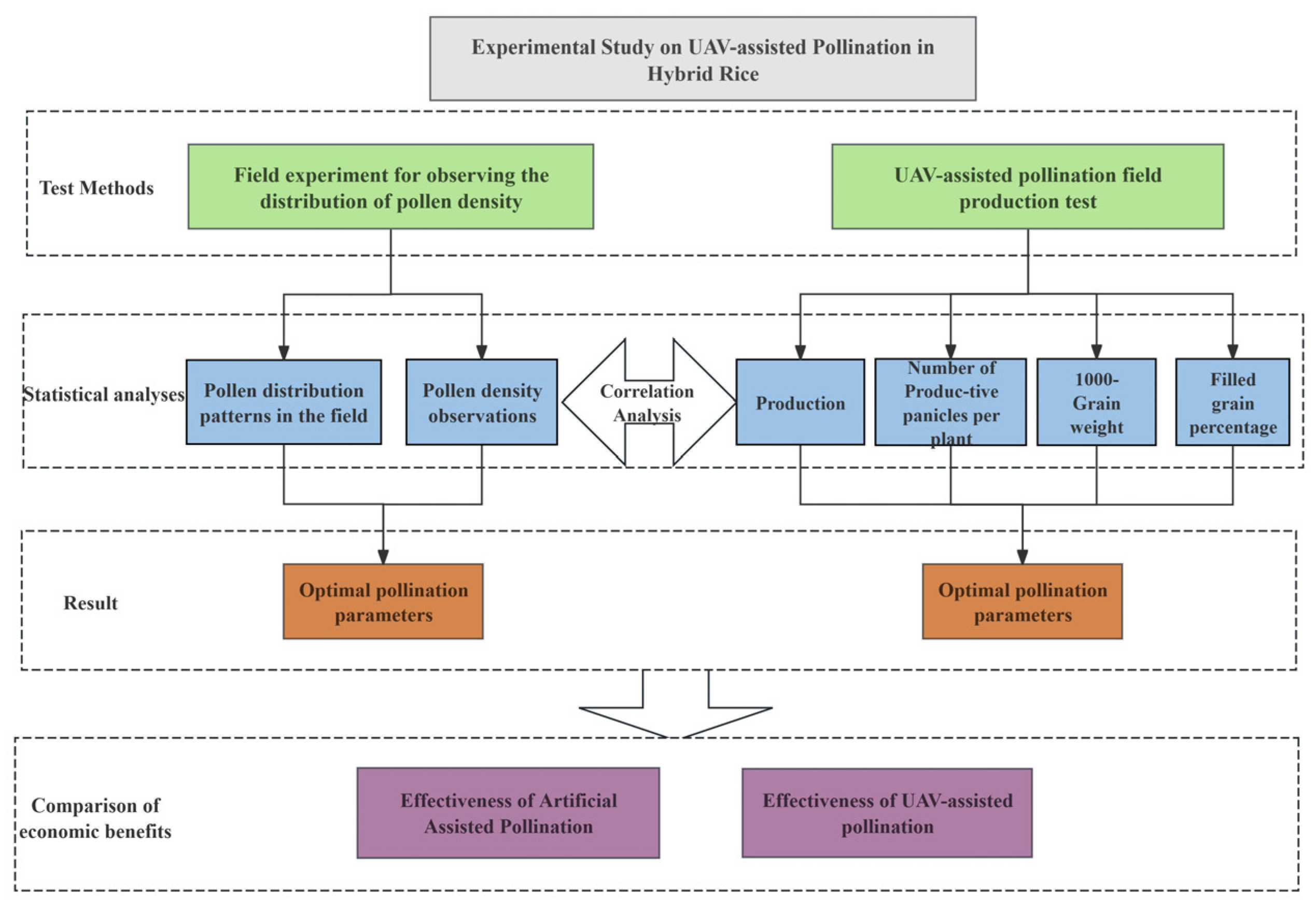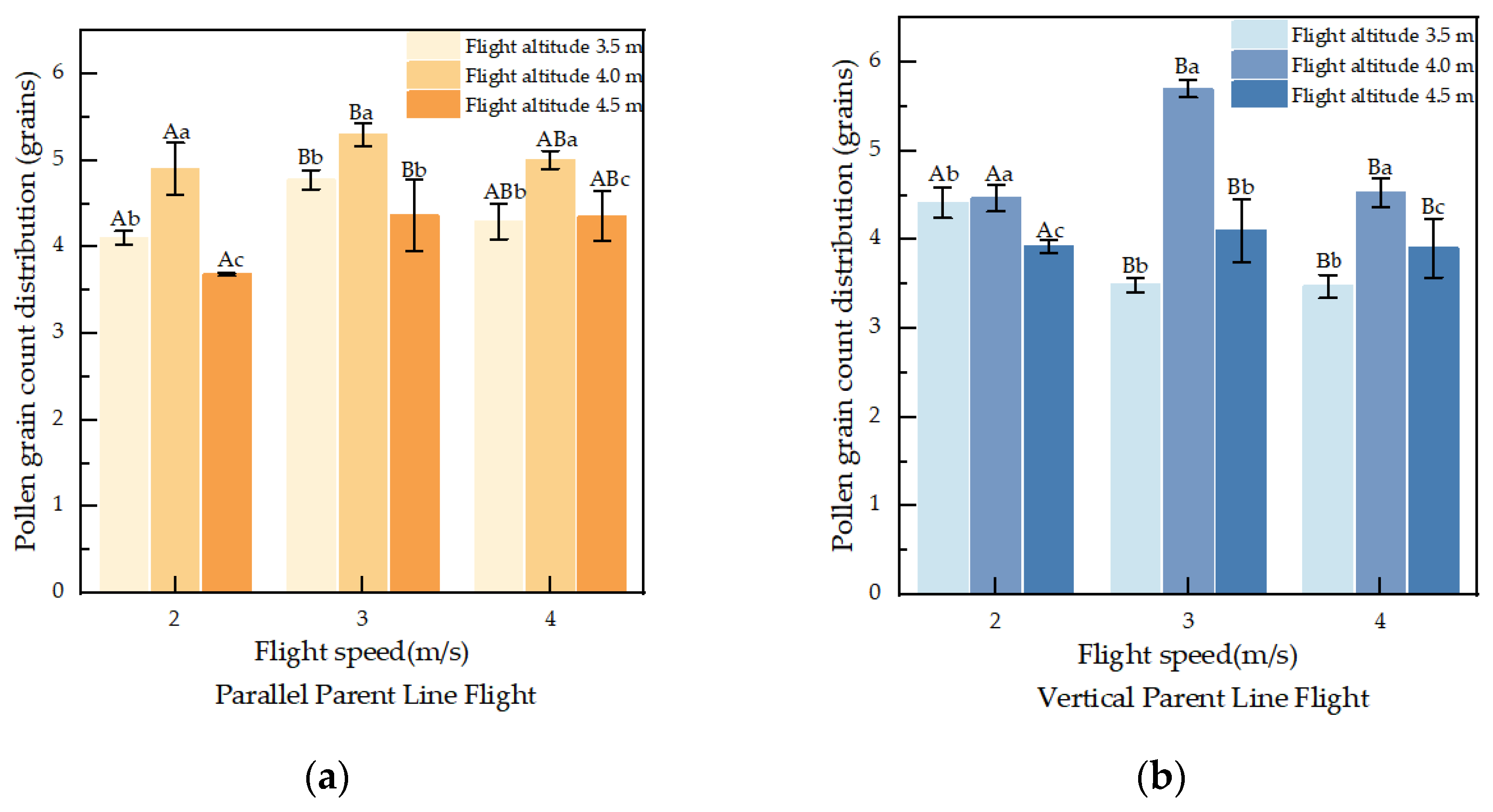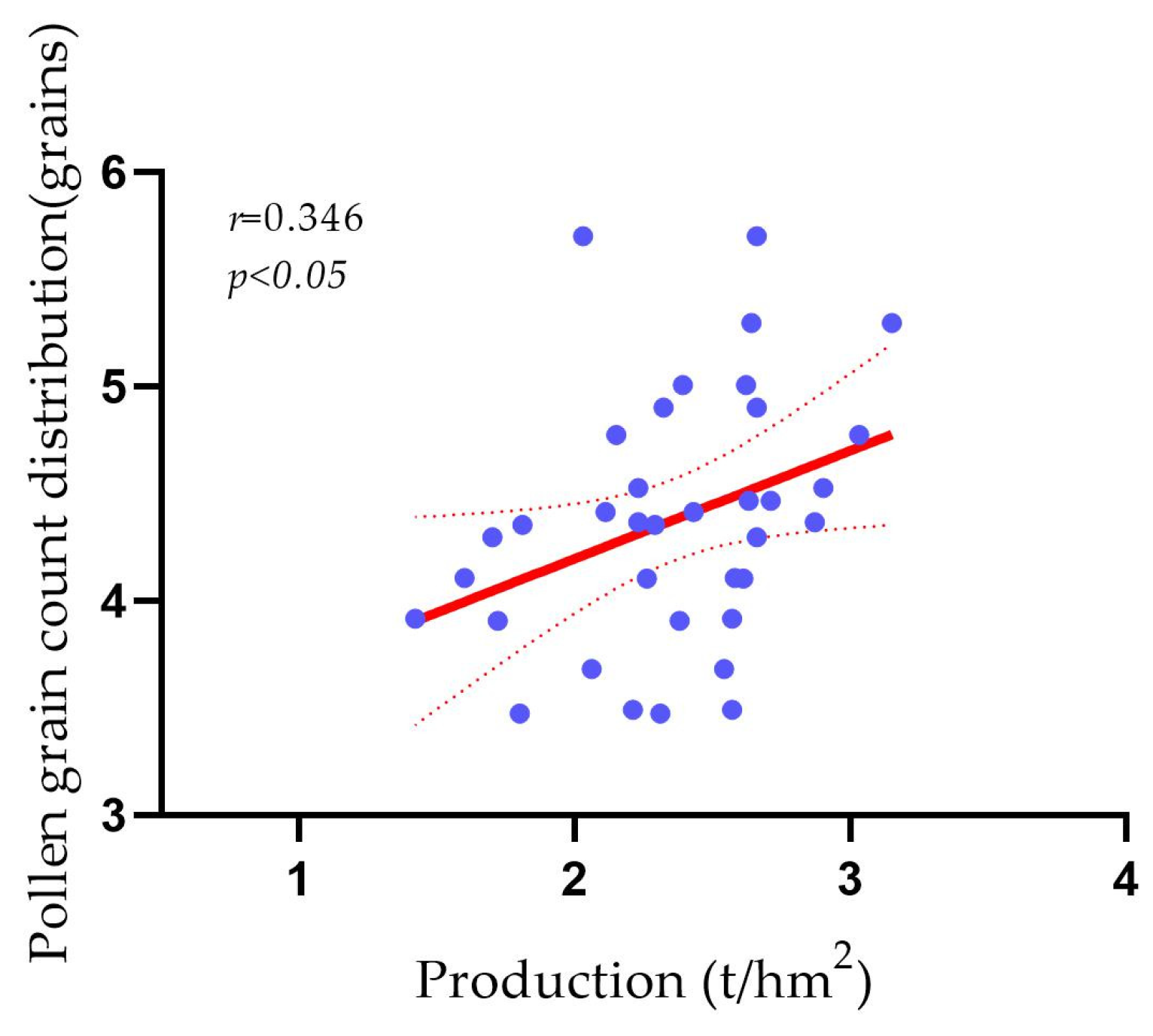Experimental Study on UAV-Assisted Pollination in Hybrid Rice
Abstract
1. Introduction
- (1)
- To compare pollination efficacy and operational efficiency between UAV-assisted and manual pollination, determining the feasibility of UAV technology substitution;
- (2)
- To establish quantitative relationships between UAV flight parameters (altitude, speed, route patterns) and pollen distribution patterns through field experiments, enabling yield prediction via pollen density analysis for accelerated parameter optimization;
- (3)
- To identify optimal operational parameters for the DJI T50 multi-rotor UAV in hybrid rice pollination, employing yield components (spikelet fertility, grain weight) as primary evaluation metrics.
2. Materials and Methods
2.1. Experimental Design
2.2. Test Methods
2.2.1. UAV-Assisted Pollination Field Production Test
- Fields ≥ 667 m2: three distinct sampling zones were established, with yield measurements repeated triplicate.
- Fields < 667 m2: sampling areas were partitioned contextually, ensuring each subdivided block exceeded 200 m2.
2.2.2. Field Experiment for Observing the Distribution of Pollen Density
2.3. Statistical Analyses
3. Results
3.1. Observations on Pollen Density Distribution in the Field
3.2. Effects of Different UAV-Assisted Pollination Parameters on Pollen Distribution Characteristics
3.3. Comparison of Seed Production Yield Between UAV-Assisted Pollination and Artificial-Assisted Pollination
3.4. Effect of Different Pollination Parameters on the Yield of Hybrid Rice Seed Production
3.5. Comparison of Cost and Efficiency of Different Pollination Methods
4. Discussion
5. Conclusions
Author Contributions
Funding
Data Availability Statement
Acknowledgments
Conflicts of Interest
Correction Statement
References
- Yang, X.; Hu, J. Progress in Hybrid Rice Breeding Technology. J. Wuhan Univ. (Nat. Sci. Ed.) 2024, 70, 556–566. [Google Scholar] [CrossRef]
- Liu, A.; Xiao, C.; Long, H. Preliminary Progress in the Research on Whole-process Mechanization Technology of Hybrid Rice Seed Production. Hybrid Rice 2014, 29, 6–8. [Google Scholar]
- He, W.; Liu, W.; Jiang, R.; Gu, Q.; Huang, J.; Zou, S.; Xu, X.; Zhou, Z. Control system design and experiments of UAV shot seeding device for rice. Trans. Chin. Soc. Agric. Eng. Trans. CSAE 2022, 38, 51–61. [Google Scholar] [CrossRef]
- Ingole, R.S.; Ingole, N.S.; Khandelwal, R.R.; Kalambe, J.P. Detection of Crop Disease and Spraying of Pesticides using Drone. In Proceedings of the 2024 IEEE 9th International Conference for Convergence in Technology (I2CT), Pune, India, 5–7 April 2024; pp. 1–5. [Google Scholar] [CrossRef]
- Liu, A.; Zhang, H.; Liao, C.; Zhang, Q.; Xiao, C.; He, J.; Zhang, J.O.; He, Y.; Li, J.; Luo, X. Effects of Supplementary Pollination by Single-rotor Agricultural Unmanned Aerial Vehicle in Hybrid Rice Seed Production. Agric. Sci. Technol. 2017, 18, 543–552. [Google Scholar] [CrossRef]
- HAshraf, H.; Ghouri, F.; Baloch, F.S.; Nadeem, M.A.; Fu, X.; Shahid, M.Q. Hybrid Rice Production: A Worldwide Review of Floral Traits and Breeding Technology, with Special Emphasis on China. Plants 2024, 13, 578. [Google Scholar] [CrossRef] [PubMed]
- Wu, S.; Liu, J.; Lei, X.; Zhao, S.; Lu, J.; Jiang, Y.; Xie, B.; Wang, M. Research Progress on Efficient Pollination Technology of Crops. Agronomy 2022, 12, 2872. [Google Scholar] [CrossRef]
- Weng, X.; Xu, J.; Zhao, J.; Huang, Y.; Bian, X.; Wang, J. Study on seed production and pollination of Indica japonica hybrid rice assisted by multi rotor UAV. J. Chin. Agric. Mech. 2022, 43, 24–29. [Google Scholar] [CrossRef]
- Jiang, Q.; Wang, Y.; Chen, J.; Wang, J.; Wei, Z.; He, Z. Optimizing the working performance of a pollination machine for hybrid rice. Comput. Electron. Agric. 2021, 187, 106282. [Google Scholar] [CrossRef]
- Wang, L.; Huang, X.; Li, W.; Yan, K.; Han, Y.; Zhang, Y.; Pawlowski, L.; Lan, Y. Progress in Agricultural Unmanned Aerial Vehicles (UAVs) Applied in China and Prospects for Poland. Agriculture 2022, 12, 397. [Google Scholar] [CrossRef]
- van der Merwe, D.; Burchfield, D.R.; Witt, T.D.; Price, K.P.; Sharda, A. Drones in agriculture. In Advances in Agronomy; Elsevier: Amsterdam, The Netherlands, 2020; Volume 162, pp. 1–30. [Google Scholar] [CrossRef]
- Dileep, M.R.; Navaneeth, A.V.; Ullagaddi, S.; Danti, A. A Study and Analysis on Various Types of Agricultural Drones and its Applications. In Proceedings of the 2020 Fifth International Conference on Research in Computational Intelligence and Communication Networks (ICRCICN), Bangalore, India, 26–27 November 2020; pp. 181–185. [Google Scholar] [CrossRef]
- Zhang, S.; Xue, X.; Chen, C.; Sun, Z.; Sun, T. Development of a low-cost quadrotor UAV based on ADRC for agricultural remote sensing. Int. J. Agric. Biol. Eng. 2019, 12, 82–87. [Google Scholar] [CrossRef]
- Zhu, W.; Feng, Z.; Dai, S.; Zhang, P.; Wei, X. Using UAV Multispectral Remote Sensing with Appropriate Spatial Resolution and Machine Learning to Monitor Wheat Scab. Agriculture 2022, 12, 1785. [Google Scholar] [CrossRef]
- Pei, H.; Sun, Y.; Huang, H.; Zhang, W.; Sheng, J.; Zhang, Z. Weed Detection in Maize Fields by UAV Images Based on Crop Row Preprocessing and Improved YOLOv4. Agriculture 2022, 12, 975. [Google Scholar] [CrossRef]
- Ahmed, S.; Qiu, B.; Ahmad, F.; Kong, C.W.; Xin, H. A State-of-the-Art Analysis of Obstacle Avoidance Methods from the Perspective of an Agricultural Sprayer UAV’s Operation Scenario. Agronomy 2021, 11, 1069. [Google Scholar] [CrossRef]
- Xu, S.; Xu, X.; Zhu, Q.; Meng, Y.; Yang, G.; Feng, H.; Yang, M.; Zhu, Q.; Xue, H.; Wang, B. Monitoring leaf nitrogen content in rice based on information fusion of multi-sensor imagery from UAV. Precis. Agric. 2023, 24, 2327–2349. [Google Scholar] [CrossRef]
- Wei, L.; Yang, H.; Niu, Y.; Zhang, Y.; Xu, L.; Chai, X. Wheat biomass, yield, and straw-grain ratio estimation from multi-temporal UAV-based RGB and multispectral images. Biosyst. Eng. 2023, 234, 187–205. [Google Scholar] [CrossRef]
- Rachmawati, S.; Putra, A.S.; Priyatama, A.; Parulian, D.; Katarina, D.; Habibie, M.T.; Siahaan, M.; Ningrum, E.P.; Medikano, A.; Valentino, V.H. Application of Drone Technology for Mapping and Monitoring of Corn Agricultural Land. In Proceedings of the 2021 International Conference on ICT for Smart Society (ICISS), Bandung, Indonesia, 2–4 August 2021; pp. 1–5. [Google Scholar] [CrossRef]
- Daud, S.M.S.M.; Yusof, M.Y.P.M.; Heo, C.C.; Khoo, L.S.; Singh, M.K.C.; Mahmood, M.S.; Nawawi, H. Applications of drone in disaster management: A scoping review. Sci. Justice 2022, 62, 30–42. [Google Scholar] [CrossRef]
- Worakuldumrongdej, P.; Maneewam, T.; Ruangwiset, A. Rice Seed Sowing Drone for Agriculture. In Proceedings of the 2019 19th International Conference on Control, Automation and Systems (ICCAS), Jeju, Republic of Korea, 15–18 October 2019; pp. 980–985. [Google Scholar] [CrossRef]
- Guzman, S.D.; Henspeter, D.; Taylor, M.; Duan, S. Drone Pollination of Flowering Vegetation for Agricultural Applications. In Proceedings of the Volume 4: Advances in Aerospace Technology, Virtual, Online, 16–19 November 2021; p. V004T04A023. [Google Scholar] [CrossRef]
- Shi, Q.; Liu, D.; Mao, H.; Shen, B.; Liu, X.; Ou, M. Study on Assistant Pollination of Facility Tomato by UAV. In Proceedings of the 2019 ASABE Annual International Meeting, Boston, MA, USA, 7–10 July 2019. [Google Scholar] [CrossRef]
- Alyafei, M.A.; Al Dakheel, A.; Almoosa, M.; Ahmed, Z.F. Innovative and Effective Spray Method for Artificial Pollination of Date Palm Using Drone. HortScience 2022, 57, 1298–1305. [Google Scholar] [CrossRef]
- Wang, Y.; Bai, R.; Lu, X.; Quan, S.; Liu, Y.; Lin, C.; Wei, J.; Su, Y.; Yao, R. Pollination Parameter Optimization and Field Verification of UAV-Based Pollination of ‘Kuerle Xiangli’. Agronomy 2022, 12, 2561. [Google Scholar] [CrossRef]
- Hu, S.; Cao, X.; Demg, Y. Impact of Plant Protection Drone Flight Parameters on Droplet Distribution for Camellia Pollination and Fruit-Setting Rate. Trans. Chin. Soc. Agric. Eng. Trans. CSAE 2023, 39, 92–100. [Google Scholar] [CrossRef]
- Wang, P.; Hu, L.; Zhou, Z.; Yang, W.; Luo, X.; Xue, X.; He, J. Wind field measurement for supplementary pollination in hybrid rice breeding using unmanned gasoline engine single-rotor helicopter. Trans. Chin. Soc. Agric. Eng. Trans. CSAE 2013, 29, 54–61. [Google Scholar]
- Li, J.; Zhou, Z.; Lan, Y.; Hu, L.; Zang, Y.; Liu, A.; Luo, X.; Zhang, T. Distribution of canopy wind field produced by rotor unmanned aerial vehicle pollination operation. Trans. Chin. Soc. Agric. Eng. Trans. CSAE 2015, 31, 77–89. [Google Scholar]
- Jiyu, L.; Lan, Y.; Jianwei, W.; Shengde, C.; Cong, H.; Qi, L.; Qiuping, L. Rice pollen distribution pattern based on small unmanned aerial vehicle wind field. China Agric. Dig. Agric. Eng. 2018, 31, 19–23. [Google Scholar] [CrossRef]
- Li, J.; Zhou, Z.; Hu, L.; Zang, Y.; Yan, M.; Liu, A.; Luo, X.; Zhang, T. Optimization of operation parameters for supplementary pollination in hybrid rice breeding using uniaxial single-rotor electric unmanned helicopter. Trans. Chin. Soc. Agric. Eng. Trans. CSAE 2014, 30, 10–17. [Google Scholar] [CrossRef]
- Shi, Q.; Liu, D.; Mao, H.; Shen, B.; Li, M. Wind-induced response of rice under the action of the downwash flow field of a multi-rotor UAV. Biosyst. Eng. 2021, 203, 60–69. [Google Scholar] [CrossRef]
- Shi, Q.; Pan, Y.; He, B.; Zhu, H.; Liu, D.; Shen, B.; Mao, H. The Airflow Field Characteristics of UAV Flight in a Greenhouse. Agriculture 2021, 11, 634. [Google Scholar] [CrossRef]
- Shi, Q.; Mao, H.; Guan, X. Numerical Simulation and Experimental Verification of the Deposition Concentration of an Unmanned Aerial Vehicle. Appl. Eng. Agric. 2019, 35, 367–376. [Google Scholar] [CrossRef]






| Main Performance Indexes | Numerical Value |
|---|---|
| Whole machine size | 2800 × 3085 × 820 mm |
| Battery capacity | 30 Ah |
| Net weight of whole machine | 39.9 kg |
| Maximum take-off weight | 52 kg |
| Operational flight speed | 1–10 m/s |
| Maximum wind speed | 6 m/s |
| Level | Element A | Element B | Element C |
|---|---|---|---|
| Route | Height/(m) | Speed/(m/s) | |
| 1 | 1 | 3.5 | 2 |
| 2 | 2 | 4 | 3 |
| 3 | 4.5 | 4 |
| Group (Mean ± Standard Deviation) | t | p | ||
|---|---|---|---|---|
| UAV-Assisted Pollination | Artificial-Assisted Pollination | |||
| Pollen density (grains/field) | 4.37 ± 0.59 | 3.68 ± 0.68 | 4.593 | <0.001 |
| Variety | Pollination Methods | Number of Productive Panicles per Plant | Filled Grain Percentage (%) | 1000-Grain Weight (g) | Production (t/hm2) |
|---|---|---|---|---|---|
| Changtian You 405 | UAV-assisted pollination | 21.62 | 15.76 | 21.94 | 2.10 |
| Artificial-assisted pollination | 17.85 | 14.50 | 21.71 | 1.73 | |
| Wanxiang You 377 | UAV-assisted pollination | 20.69 | 34.20 | 20.15 | 2.61 |
| Artificial-assisted pollination | 21.15 | 32.90 | 20.18 | 2.35 |
| Route | Flight Speed (m/s) | Flying Height (m) | Test Area (m2) | Number of Productive Panicles per Plant | Filled Grain Per-Centage ± Standard Deviation (%) | 1000-Grain Weight (g) | Production ± Standard Deviation (t/hm2) |
|---|---|---|---|---|---|---|---|
| Parallel Parentage | 2 | 3.5 | 1067 | 19.11 | 13.04 ± 2.20 Bb | 21.80 | 1.60 ± 0.16 Bb |
| 4.0 | 667 | 22.00 | 19.43 ± 6.40 Ba | 22.01 | 2.32 ± 0.29 Ba | ||
| 4.5 | 1467 | 21.78 | 11.08 ± 0.49 Bb | 22.07 | 2.06 ± 0.08 Bb | ||
| 3 | 3.5 | 667 | 19.28 | 17.89 ± 2.82 Ab | 22.24 | 2.15 ± 0.00 Ab | |
| 4.0 | 667 | 18.11 | 22.21 ± 7.11 Aa | 21.88 | 2.64 ± 0.00 Aa | ||
| 4.5 | 1067 | 28.72 | 20.25 ± 0.44 Ab | 22.16 | 2.23 ± 0.37 Ab | ||
| 4 | 3.5 | 1868 | 24.78 | 13.51 ± 6.83 Bb | 22.13 | 1.70 ± 0.00 Bb | |
| 4.0 | 1067 | 19.67 | 18.94 ± 3.45 Ba | 22.67 | 2.39 ± 0.38 Ba | ||
| 4.5 | 867 | 19.67 | 14.89 ± 2.86 Bb | 22.06 | 1.81 ± 0.10 Bb | ||
| Vertical parentage | 2 | 3.5 | 934 | 22.78 | 16.03 ± 0.34 Bb | 21.80 | 1.80 ± 0.36 Bb |
| 4.0 | 734 | 17.78 | 20.20 ± 1.60 Ba | 21.94 | 2.23 ± 0.60 Ba | ||
| 4.5 | 1134 | 20.56 | 9.35 ± 3.69 Bb | 21.70 | 2.38 ± 0.67 Bb | ||
| 3 | 3.5 | 734 | 20.28 | 13.84 ± 2.48 Ab | 21.52 | 2.11 ± 0.00 Ab | |
| 4.0 | 734 | 21.56 | 19.11 ± 3.51 Aa | 21.55 | 2.63 ± 0.12 Aa | ||
| 4.5 | 867 | 19.50 | 17.36 ± 0.80 Ab | 22.59 | 1.42 ± 0.27 Ab | ||
| 4 | 3.5 | 2735 | 24.61 | 10.19 ± 0.75 Bb | 21.16 | 2.21 ± 0.46 Bb | |
| 4.0 | 1267 | 25.72 | 17.67 ± 0.33 Ba | 21.76 | 2.03 ± 0.03 Ba | ||
| 4.5 | 1201 | 23.28 | 14.50 ± 3.53 Bb | 21.80 | 2.26 ± 0.03 Bb |
| Route | Flight Speed (m/s) | Flying Height (m) | Test Area (m2) | Number of Productive Panicles per Plant | Filled Grain Per-Centage ± Standard Deviation(%) | 1000-Grain Weight (g) | Production ± Standard Deviation (t/hm2) |
| Parallel Parentage | 2 | 3.5 | 2201 | 18.67 | 34.55 ± 6.09 Ab | 20.53 | 2.58 ± 0.08 Bb |
| 4.0 | 1334 | 16.78 | 32.24 ± 0.48 Aa | 20.00 | 2.66 ± 0.17 Ba | ||
| 4.5 | 1334 | 14.33 | 37.26 ± 8.25 Ab | 20.11 | 2.54 ± 0.02 Bc | ||
| 3 | 3.5 | 867 | 19.11 | 30.69 ± 3.05 Ab | 20.00 | 3.03 ± 0.07 Ab | |
| 4.0 | 934 | 17.00 | 39.01 ± 4.10 Aa | 19.48 | 3.15 ± 0.11 Aa | ||
| 4.5 | 2401 | 16.89 | 31.33 ± 2.51 Ab | 20.49 | 2.87 ± 0.03 Ac | ||
| 4 | 3.5 | 2201 | 20.44 | 33.27 ± 1.31 Bb | 20.44 | 2.66 ± 0.06 Cb | |
| 4.0 | 2201 | 22.67 | 38.26 ± 1.90 Ba | 20.86 | 2.62 ± 0.11 Ca | ||
| 4.5 | 2201 | 22.22 | 31.13 ± 8.85 Bb | 19.97 | 2.29 ± 0.09 Cc | ||
| Vertical parentage | 2 | 3.5 | 2335 | 20.44 | 30.65 ± 1.68 Ab | 20.68 | 2.43 ± 0.01 Bb |
| 4.0 | 1334 | 18.44 | 40.24 ± 5.20 Aa | 20.09 | 2.71 ± 0.28 Ba | ||
| 4.5 | 934 | 17.00 | 34.93 ± 2.95 Ab | 20.27 | 2.57 ± 0.17 Bc | ||
| 3 | 3.5 | 1801 | 28.89 | 41.10 ± 3.02 Ab | 20.47 | 2.57 ± 0.08 Ab | |
| 4.0 | 1868 | 25.22 | 34.39 ± 1.57 Aa | 20.24 | 2.66 ± 0.20 Aa | ||
| 4.5 | 2001 | 30.00 | 33.09 ± 4.20 Ab | 20.11 | 2.61 ± 0.03 Ac | ||
| 4 | 3.5 | 1934 | 18.67 | 28.24 ± 7.65 Bb | 19.75 | 2.31 ± 0.23 Cb | |
| 4.0 | 1601 | 18.44 | 36.24 ± 1.42 Ba | 20.26 | 2.90 ± 0.25 Ca | ||
| 4.5 | 1201 | 27.11 | 30.89 ± 2.63 Bb | 19.02 | 1.72 ± 0.07 Cc |
| Pollination | Cost (USD/667 m2) | Work Efficiency (hm2/h) |
|---|---|---|
| UAV-assisted pollination | 2.21 | 4.00 |
| Artificial-assisted pollination | 2.76 | 0.67 |
Disclaimer/Publisher’s Note: The statements, opinions and data contained in all publications are solely those of the individual author(s) and contributor(s) and not of MDPI and/or the editor(s). MDPI and/or the editor(s) disclaim responsibility for any injury to people or property resulting from any ideas, methods, instructions or products referred to in the content. |
© 2025 by the authors. Licensee MDPI, Basel, Switzerland. This article is an open access article distributed under the terms and conditions of the Creative Commons Attribution (CC BY) license (https://creativecommons.org/licenses/by/4.0/).
Share and Cite
Long, L.; Lin, J.; Liu, M.; Chen, X.; Fang, P.; Xiao, L.; Zhou, Y.; Dong, X. Experimental Study on UAV-Assisted Pollination in Hybrid Rice. Drones 2025, 9, 327. https://doi.org/10.3390/drones9050327
Long L, Lin J, Liu M, Chen X, Fang P, Xiao L, Zhou Y, Dong X. Experimental Study on UAV-Assisted Pollination in Hybrid Rice. Drones. 2025; 9(5):327. https://doi.org/10.3390/drones9050327
Chicago/Turabian StyleLong, Le, Jinlong Lin, Muhua Liu, Xiongfei Chen, Peng Fang, Liping Xiao, Yihan Zhou, and Xiaoya Dong. 2025. "Experimental Study on UAV-Assisted Pollination in Hybrid Rice" Drones 9, no. 5: 327. https://doi.org/10.3390/drones9050327
APA StyleLong, L., Lin, J., Liu, M., Chen, X., Fang, P., Xiao, L., Zhou, Y., & Dong, X. (2025). Experimental Study on UAV-Assisted Pollination in Hybrid Rice. Drones, 9(5), 327. https://doi.org/10.3390/drones9050327








